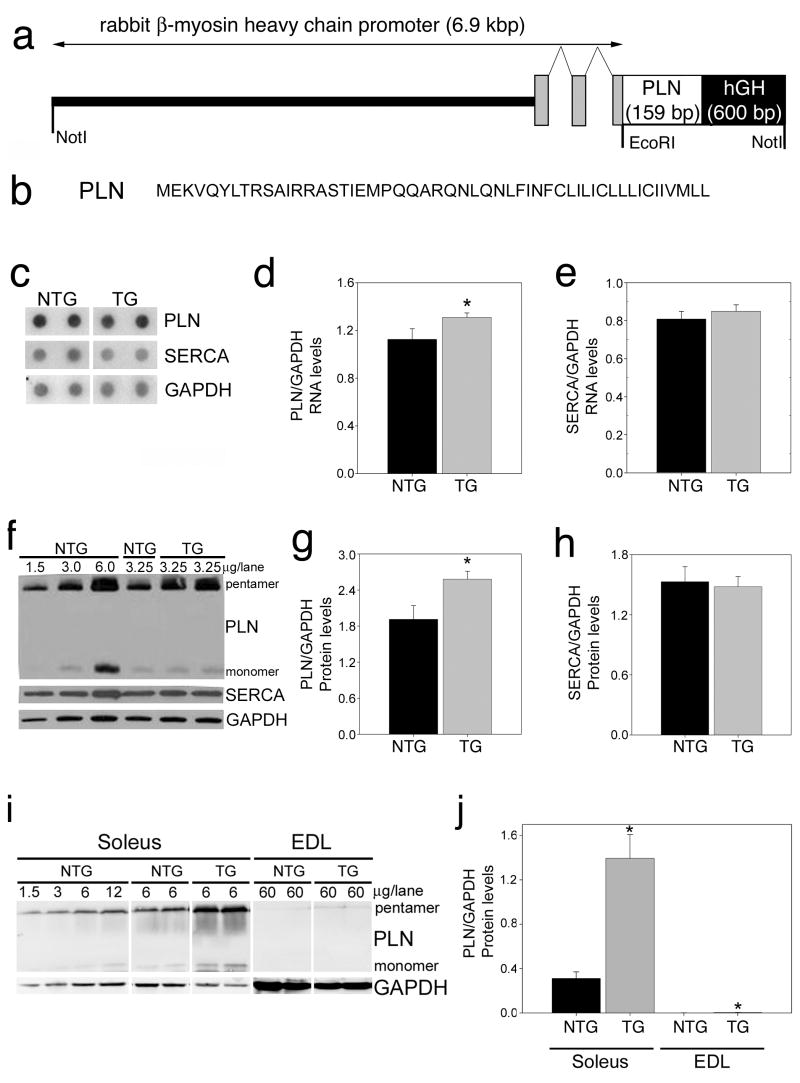Figure 1.
Transgenic modulation of phospholamban in the rabbit heart. (a) Construct design. The rabbit β-myosin heavy chain (β-MyHC) promoter region was used to drive the rabbit phospholamban coding sequence, flanked by a human growth hormone polyadenylation signal (hGH polyA). The exon-intron structure composing the 5′-untranslated sequence of β-MyHC is denoted by grey rectangles/line respectively. (b) Amino acid sequence of the wild-type phospholamban construct. (c) Representative RNA dot blots of phospholamban and sarcoplasmic/endoplasmic reticulum Ca2+-ATPase (SERCA) expression from two of six different rabbits are shown. Each dot represents an individual rabbit and shows the reproducibility of phospholamban expression within a line. Ventricular RNA isolated from 6-month old rabbits of both genders was probed for phospholamban and sarcoplasmic/endoplasmic reticulum Ca2+-ATPase. Duplicate blots were done and the data normalized to glyceraldehyde 3-phosphate dehydrogenase (GAPDH) RNA expression. (d) Total phospholamban levels normalized to glyceraldehyde 3-phosphate dehydrogenase expression (n = 6/genotype). *P < 0.05 vs. nontransgenic (NTG) based Student’s t-test. (e) Normalized sarcoplasmic/endoplasmic reticulum Ca2+-ATPase expression was unchanged by phospholamban overexpression. (f) Representative immunoblot of cardiac homogenates isolated from six month old nontransgenic and transgenic rabbit ventricles showing pentameric and monomeric phospholamban separated by SDS-PAGE and probed with specific monoclonal antibodies. Sarcoplasmic/endoplasmic reticulum Ca2+-ATPase 2a and glyceraldehyde 3-phosphate dehydrogenase levels were also determined. (g) phospholamban expression in the transgenic rabbit hearts was significantly increased relative to the nontransgenic hearts. Glyceraldehyde 3-phosphate dehydrogenase was used as a loading control. *, P < 0.05 vs. nontransgenic. (h) Quantitation of sarcoplasmic/endoplasmic reticulum Ca2+-ATPase levels revealed that the expression in the transgenic rabbit hearts was not changed compared to levels seen in nontransgenic rabbit hearts. (i, j) Skeletal muscle expression of phospholamban in the viable transgenic founder. Shown are multiple dilutions of protein derived from the indicated muscles. Note the robust expression in the slow type soleus and lack of expression in the extensor digitorum longus (EDL) fast twitch muscle.

